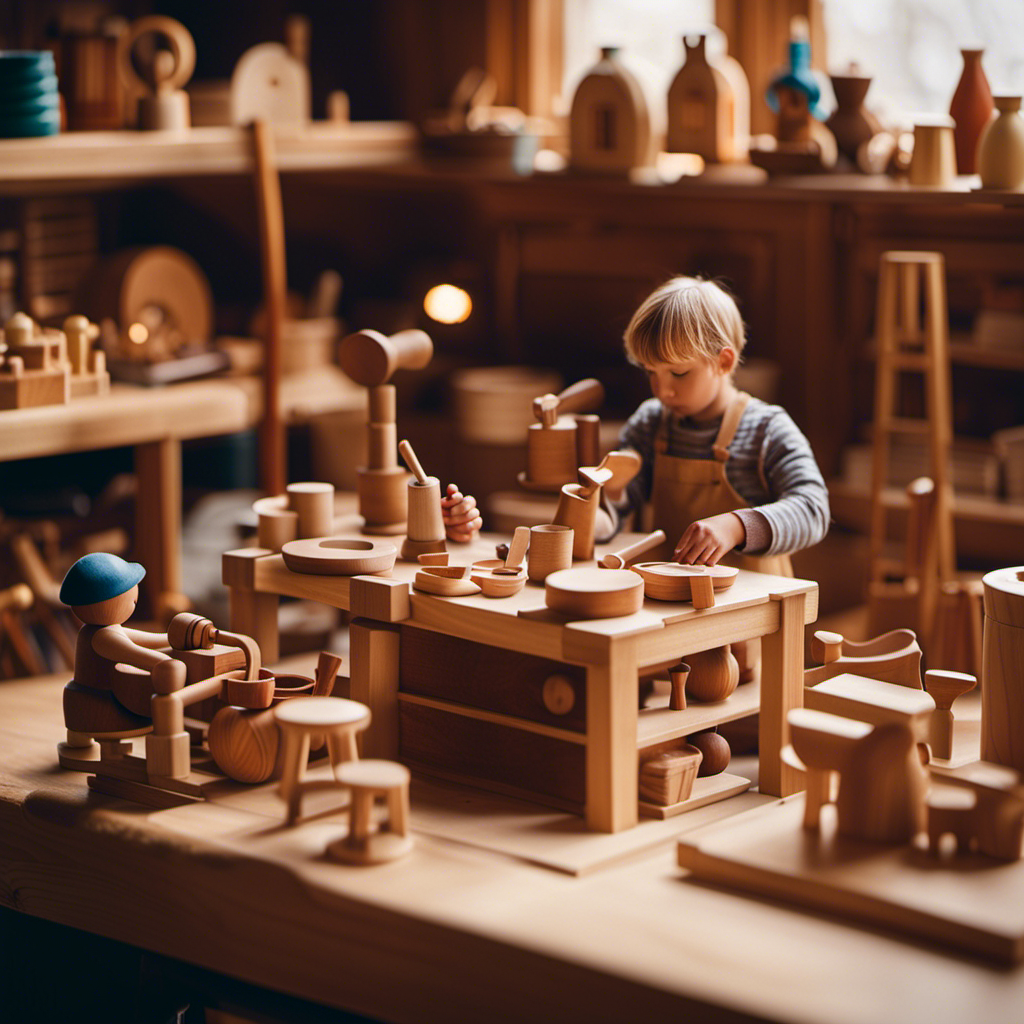Delving into Steiner’s theoretical cosmos uncovers the origins and impacts of Waldorf toys.
Rudolf Steiner, a remarkable individual, laid the foundation for Waldorf education, emphasizing the role of play in a child’s development.
These toys, with their natural materials and thoughtful design, foster creativity and imagination.
In this article, I will explore the principles of Waldorf toys, comparing them to the Montessori method and addressing modern concerns in the digital age.
Join me on this journey as we uncover the global reach and future adaptation of Waldorf toys.
Key Takeaways
- Steiner’s philosophy shaped Waldorf education and the development of Waldorf toys.
- Waldorf toys are designed to stimulate imagination and creativity.
- Waldorf education aims to foster creativity, critical thinking, and a love for learning.
- Waldorf toys emphasize simplicity, natural materials, and a strong connection to nature.
The Life of Rudolf Steiner: A Brief Overview
Rudolf Steiner’s life is a fascinating journey that has had a significant impact on the development of Waldorf toys.
Steiner was born in 1861 in Austria and went on to become a philosopher, scientist, and educator.
His philosophy and beliefs formed the foundation of what is now known as Waldorf education, which emphasizes a holistic approach to child development.
Steiner believed that children should be nurtured in a way that integrates their intellectual, emotional, and physical development.
This holistic approach influenced the creation of Waldorf toys, which are designed to stimulate children’s imagination and creativity.
These toys are often made from natural materials and are free from commercial branding or excessive stimulation.
Steiner’s impact on the development of Waldorf toys is undeniable, as his philosophy continues to shape the way we think about childhood and play.
As Waldorf education began to gain popularity, the early development of Waldorf toys followed suit.
The Early Development of Waldorf Education
The early development of Waldorf education was influenced by the teachings of Rudolf Steiner in the early 20th century. Steiner’s educational philosophy formed the foundation for the establishment of the first Waldorf school in Stuttgart, Germany in 1919.
These early Waldorf schools aimed to provide a holistic education that nurtured the physical, emotional, and intellectual development of children. Steiner believed that education should cater to the individual needs of each child, fostering creativity, critical thinking, and a love for learning.
The curriculum was designed to integrate academic subjects with artistic and practical activities, allowing children to explore their interests and develop a well-rounded set of skills. This approach to education gained popularity and led to the establishment of Waldorf schools worldwide.
Transitioning into the role of play in Steiner’s philosophy, it becomes evident that play holds a central place in the development of children according to Steiner’s beliefs.
The Role of Play in Steiner’s Philosophy
As a parent, I’ve come to appreciate the importance of imaginative play in my child’s development.
Not only does it allow them to explore their creativity and imagination, but it also helps in their cognitive, social, and emotional development.
Through play, children learn to problem solve, cooperate with others, and express their feelings and ideas in a safe and enjoyable way.
It is truly a holistic approach to their overall development.
Importance of Imaginative Play
Imaginative play encourages creativity and problem-solving skills in children. The benefits of unstructured play are well-documented, and research shows that imaginative play plays a crucial role in cognitive development. When children engage in imaginative play, they are actively using their imagination to create scenarios, characters, and narratives. This type of play allows children to explore different roles, experiment with ideas, and solve problems through creative thinking.
As they engage in pretend play, children develop their language skills, social skills, and emotional intelligence. They learn to negotiate, cooperate, and communicate effectively with others. Additionally, imaginative play helps children develop their cognitive abilities, such as memory, attention, and problem-solving skills. It allows them to think critically, make decisions, and come up with unique solutions.
Transitioning into the next section, play as holistic development encompasses not only cognitive development but also physical, social, and emotional growth.
Play as Holistic Development
Play contributes to the holistic development of children by promoting physical, social, and emotional growth. It is through play that children learn valuable skills and acquire knowledge about the world around them. Here are three ways in which play-based learning benefits children’s holistic development:
-
Promotes physical development: Play allows children to engage in physical activities such as running, jumping, and climbing, which helps develop their motor skills, coordination, and strength.
-
Enhances social skills: Play provides children with opportunities to interact with their peers, fostering the development of important social skills like sharing, taking turns, and cooperating. It also helps them develop empathy and understanding towards others.
-
Stimulates creativity: Play encourages children to use their imagination, creativity, and problem-solving skills. Through pretend play and role-playing, children can explore different roles, situations, and ideas, which supports their cognitive development.
By incorporating play into their learning experiences, children develop holistically, gaining not only knowledge and skills but also a sense of joy and curiosity.
Transitioning into the subsequent section, let’s now explore the principles of Waldorf toys and their impact on children’s development.
Exploring the Principles of Waldorf Toys
The principles of Waldorf toys emphasize simplicity and natural materials. These toys are designed to inspire imaginative play, allowing children to explore their creativity and develop important cognitive and emotional skills. By using natural materials such as wood, wool, and cotton, Waldorf toys provide a sensory experience that is both calming and stimulating.
The simple and open-ended design of these toys encourages children to use their imagination and create their own stories and scenarios. Through imaginative play, children learn problem-solving skills, develop language and social skills, and enhance their emotional intelligence. The benefits of imaginative play extend beyond childhood, as it fosters creativity, critical thinking, and innovation in adulthood.
As we delve deeper into the influence of nature in Waldorf toy design, we will see how these principles are reflected in the choice of materials and the overall aesthetic.
The Influence of Nature in Waldorf Toy Design
The principles of Waldorf toy design are deeply rooted in the belief that children should have a strong connection to nature. This influence is evident in the design of these toys, which often incorporate natural materials and elements inspired by the natural world.
Waldorf toys are designed to stimulate children’s imaginations, encourage open-ended play, and foster a sense of wonder and curiosity.
One way this is achieved is through the use of organic shapes and textures in the design of the toys. For example, wooden blocks may have irregular shapes and natural grain patterns, allowing children to explore the tactile qualities of the material.
Additionally, Waldorf toys often draw inspiration from nature in their themes and motifs. Animals, plants, and natural landscapes are commonly depicted in Waldorf toys, further connecting children to the natural world and encouraging a sense of appreciation and respect for the environment.
The importance of natural materials in Waldorf toys will be discussed in the subsequent section.
The Importance of Natural Materials in Waldorf Toys
Using natural materials in Waldorf toys allows you to provide your child with a sensory-rich play experience that connects them to the beauty and textures of the natural world. Here are three reasons why natural materials are important in Waldorf toys:
-
Importance of sustainability: By using natural materials such as wood, cotton, and wool, Waldorf toys promote sustainable practices. These materials are renewable, biodegradable, and non-toxic, making them better for the environment and your child’s health.
-
Benefits of open-ended play: Natural materials in Waldorf toys encourage open-ended play, where children can use their imagination and creativity to explore and create. Unlike toys with flashing lights and loud sounds, Waldorf toys allow children to engage in self-directed play, fostering problem-solving skills and independent thinking.
-
Connection to nature: Natural materials evoke a sense of connection to the natural world. When children play with wooden blocks, they can feel the grain and warmth of the wood, creating a tactile experience that is lacking in plastic toys. This connection to nature can inspire a love and appreciation for the environment.
How Waldorf Toys Encourage Imagination and Creativity
Incorporating natural materials into Waldorf toys helps foster a sense of imagination and creativity in children.
Waldorf toys are designed to encourage open-ended play, allowing children to use their imagination and explore different possibilities.
By using natural materials such as wood, silk, and cotton, Waldorf toys provide a sensory experience that stimulates a child’s creativity and curiosity.
These toys do not have a predetermined purpose or outcome, allowing children to freely explore and create their own narratives.
This type of play promotes problem-solving skills, critical thinking, and cognitive development.
It also helps children develop their social and emotional skills as they engage in pretend play and collaborate with others.
The benefits of Waldorf toys in early childhood development are vast, and they play a crucial role in nurturing a child’s overall growth and well-being.
The Role of Waldorf Toys in Child Development
When it comes to child development, Waldorf toys play a crucial role in fostering imagination and creativity. These toys are designed to encourage open-ended play, allowing children to explore and express their ideas freely.
Additionally, Waldorf toys promote sensory development through their use of natural materials and textures, providing children with a tactile and engaging play experience.
Waldorf Toys and Creativity
Creativity is encouraged through the use of Waldorf toys. These toys are designed to promote open-ended play and foster a child’s imagination. Here are three key ways in which Waldorf toys support creativity:
-
Limitless Possibilities: Waldorf toys are intentionally simple, allowing children to use their imagination to transform them into whatever they desire. Whether it’s wooden blocks, dolls, or play silks, these toys provide endless opportunities for children to create their own stories and worlds.
-
Natural Materials: Waldorf toys are often made from natural materials such as wood, cotton, and silk. These materials have a sensory appeal and stimulate a child’s senses, enhancing their play experience and sparking their creativity.
-
Unstructured Play: Waldorf toys do not come with instructions or pre-determined outcomes. This allows children to explore and experiment freely, giving them the freedom to solve problems and think creatively.
Sensory Development Through Play
As we learned in the previous section, Waldorf toys are known for their emphasis on creativity and open-ended play. Now, let’s explore another important aspect of play that is central to Waldorf philosophy: sensory development.
Sensory play involves engaging a child’s senses through different activities and materials. This type of play has numerous benefits for children’s overall development. It helps them build motor skills, enhance cognitive abilities, and develop language and social skills. Sensory play also promotes problem-solving and creativity while fostering a sense of curiosity and exploration.
Incorporating sensory play into everyday activities can be quite simple. Here is a table showcasing different sensory play ideas and how they can be integrated into daily routines:
| Sensory Play Ideas | Everyday Activities |
|---|---|
| Playdough | Mealtime |
| Water Play | Bath time |
| Sensory Bins | Outdoor play |
| Nature Walks | Family outings |
By incorporating these activities into daily routines, parents and caregivers can provide children with rich sensory experiences that support their overall development.
Now, let’s delve into the fascinating world of Waldorf toy-making: from workshop to classroom.
Waldorf Toy-Making: From Workshop to Classroom
Waldorf toy-making has evolved from a workshop setting to being incorporated into classrooms. The techniques used in Waldorf toy-making focus on using natural materials such as wood, wool, and cotton, which are believed to be more conducive to imaginative play and sensory exploration.
These toys are designed to be simple and open-ended, allowing children to use their creativity and imagination to engage in play that promotes cognitive, emotional, and physical development.
The benefits of Waldorf toys in early education are numerous. They encourage children to use their senses, develop fine motor skills, problem-solving abilities, and foster a sense of wonder and curiosity.
The Impact of Waldorf Toys on Early Childhood Education
When it comes to early childhood education, two key aspects that cannot be overlooked are enhanced sensory development and fostering imaginative play.
These elements play a crucial role in a child’s overall development and have a significant impact on their cognitive, emotional, and social skills.
Enhanced Sensory Development
You can enhance your child’s sensory development through the use of Waldorf toys. These toys are designed to engage children in sensory exploration and provide them with tactile stimulation.
Here are five ways in which Waldorf toys can enhance your child’s sensory development:
-
Natural Materials: Waldorf toys are often made from natural materials such as wood and organic fabrics, which provide different textures for your child to explore.
-
Open-Ended Play: These toys encourage open-ended play, allowing children to use their imagination and explore various sensory experiences.
-
Simple Design: Waldorf toys have a simple design without unnecessary lights or sounds, allowing children to focus on the sensory aspects of play.
-
Unstructured Play: With Waldorf toys, children are free to play in an unstructured manner, which promotes sensory exploration and creativity.
-
Hands-On Experience: These toys provide hands-on experience, allowing children to touch, feel, and manipulate objects, thereby enhancing their sensory development.
Fostering Imaginative Play
To foster imaginative play, it is important to encourage your child to create their own stories and characters using their toys. This type of play is essential for cognitive development and offers numerous benefits for children. It helps them develop problem-solving skills, creativity, and social-emotional skills. Engaging in imaginative play allows children to think critically, explore different perspectives, and express their emotions.
As parents, we have a crucial role in fostering imaginative play. We can provide open-ended toys that allow for creativity, such as building blocks, dolls, or dress-up costumes. Creating a supportive environment where children feel encouraged to explore their imagination and engage in pretend play is also important. Actively participating and showing interest in their play can enhance their imaginative experiences.
Transitioning into the next section about ‘waldorf toys and the montessori method: a comparison,’ it is important to understand the different approaches to fostering imaginative play.
Waldorf Toys and the Montessori Method: A Comparison
Although Waldorf toys and the Montessori method have some similarities, they also have distinct differences in their approach to education.
When it comes to toys, one key difference is that Waldorf toys are often handmade and made of natural materials, while Montessori toys can be more varied and include both natural and synthetic materials.
Another difference is that Waldorf toys tend to be more open-ended, allowing for imaginative play and creativity, while Montessori toys are often designed to teach specific skills and concepts.
The benefits of open-ended play with Waldorf toys include fostering creativity, problem-solving skills, and social interaction.
Transitioning into the next section, in the digital age, there are concerns about the impact of technology on children’s play and development.
Waldorf Toys in the Digital Age: Addressing Modern Concerns
In the digital age, it’s important to address concerns about how technology affects children’s play and development. As parents and educators, we strive to strike a balance between the benefits and drawbacks of screen time.
When it comes to Waldorf toys, they offer a refreshing alternative that promotes imagination, creativity, and hands-on learning. Here are three key reasons why Waldorf toys are a valuable resource in the digital age:
- Digital detox: Waldorf toys provide a much-needed break from electronic devices and screens, allowing children to engage in open-ended play and explore their surroundings without distractions.
- Screen time limits: By encouraging children to play with Waldorf toys, we can help establish healthy screen time habits and reduce excessive exposure to technology.
- Holistic development: Waldorf toys are designed to stimulate all aspects of a child’s development, including their physical, social, emotional, and cognitive skills.
Transitioning into the subsequent section about the global reach of Waldorf toys: international perspectives, it is fascinating to explore how Waldorf principles and toys have gained recognition and adoption around the world.
The Global Reach of Waldorf Toys: International Perspectives
As we explored the impact of Waldorf toys in the digital age, it became evident that these toys address modern concerns and provide a valuable alternative to screen time.
Now, let’s take a closer look at the global reach of Waldorf toys and their international perspectives.
One of the remarkable aspects of Waldorf toys is their ability to foster international collaboration and cross-cultural impact. These toys have gained popularity worldwide, transcending borders and cultural barriers. Waldorf schools and communities around the globe have embraced these toys as valuable tools for holistic child development. They have become a bridge between different cultures, promoting understanding and mutual respect.
From Europe to Asia, North America to Africa, Waldorf toys have left a lasting impression on children and adults alike. The universal appeal of these toys lies in their simplicity and emphasis on imaginative play. They provide a common ground for children from diverse backgrounds to come together and learn through play.
With a global network of Waldorf schools and enthusiasts, the future of Waldorf toys holds great potential for adapting to changing times. Let’s explore how these toys are evolving to meet the needs of the modern world.
The Future of Waldorf Toys: Adapting to Changing Times
With advancements in technology and changing educational practices, Waldorf toys are continuously evolving to meet the needs of the modern world. Adapting to technology is a key aspect of this evolution.
While traditional Waldorf toys often focus on open-ended play and imagination, there is now a growing emphasis on incorporating technology in a thoughtful and age-appropriate way. For example, some Waldorf toys now include elements of coding or robotics, encouraging children to develop problem-solving skills while still engaging their creativity.
Additionally, there is a strong commitment to using sustainable materials in the production of Waldorf toys. Many companies are opting for natural and biodegradable materials, such as wood, organic cotton, and beeswax. This not only aligns with the principles of Waldorf education but also promotes environmental consciousness and responsible consumption.
Frequently Asked Questions
What Are Some Examples of Specific Waldorf Toys?
Some examples of specific Waldorf toys include wooden blocks, knitted dolls, and natural materials such as silk scarves and wooden animals. Playing with Waldorf toys can enhance creativity, imagination, and fine motor skills.
How Do Waldorf Toys Differ From Mainstream Toys?
Waldorf toys differ from mainstream toys in that they focus on simplicity, natural materials, and open-ended play. This approach encourages creativity, imagination, and problem-solving skills, benefiting children’s cognitive, emotional, and social development.
Are Waldorf Toys Suitable for Children of All Ages?
Yes, Waldorf toys are suitable for children of all ages. They offer benefits such as promoting creativity, imagination, and sensory development. However, it’s important to consider individual needs and preferences, including children with special needs.
How Do Waldorf Toys Promote Holistic Development?
Waldorf toys promote holistic development by fostering imagination and promoting creativity. They encourage open-ended play and engage children in activities that stimulate their cognitive, emotional, and physical growth.
Can Waldorf Toys Be Easily Incorporated Into Traditional Educational Settings?
Integrating Waldorf toys in traditional classrooms can enhance learning experiences. They promote creativity, imagination, and hands-on engagement. The benefits include holistic development, fostering critical thinking skills, and creating a balanced and child-centered educational environment.
Conclusion
In conclusion, the captivating journey of Waldorf toys has taught me that Rudolf Steiner’s vision is undeniably powerful. Steiner’s philosophy, rooted in play and nature, has birthed toys that are not only educational but enchanting.
Through the comparison to the Montessori method and the exploration of modern concerns, it is clear that these toys have stood the test of time.
As Waldorf toys continue to adapt and evolve, their global reach expands, promising a future that is as bright and beautiful as the toys themselves.










